Вы не зашли.
Объявление
"Давайте только проявлять больше внимания, терпимости и уважения к чужому мнению — вот и всё." — Gennadius.
— О размещении изображений на форуме, О рекламе на форуме
#2176 16 March 2016 20:50:39
- дима х
- Без пяти минут зоолог
- Зарегистрирован: 08 March 2016
- Сообщений: 7564
Re: Серый, или обыкновенный волк (Canis lupus)
Неудачно сформулировал, надо было написать "не гибриды" или что-то в этом роде.
Неактивен
#2177 16 March 2016 20:56:13
- Crazy Zoologist
- Гость
Re: Серый, или обыкновенный волк (Canis lupus)
Kelly :
Почему вы считаете гибридов собаки и волка нечистокровными, когда согласно современным представлениям собака это не отдельный вид, а подвид волка?
Конечно они нечистокровные. Помеси разных пород собак также считаются нечистокровными.
#2178 16 March 2016 21:20:59
- дима х
- Без пяти минут зоолог
- Зарегистрирован: 08 March 2016
- Сообщений: 7564
Re: Серый, или обыкновенный волк (Canis lupus)
Просто неудачно сформулировал вопрос, надо было написать "не гибриды" или что-то в этом роде. Кроме того, гибриды у волков бывают не только с домашними собаками (есть данные про койотов. не знаю. есть ли ещё какие нибудь гибриды с участием волков).
Неактивен
#2179 16 March 2016 21:37:55
Re: Серый, или обыкновенный волк (Canis lupus)
Есть еще помести с шакалами, в просторечии называемые "шабаками". В дебрях проблемы - сколько людей, столько мнений, кто-то считает собаку близкой к волку, но у волка челюсти ближе к челюстям хищника, кто-то близкой к шакалу, у которого челюсти ближе к челюстям падальщика. Другое дело, что все признают, что волки с собаками столько смешивались и перемешивались, что генетически это самые близкие линии.
Неактивен
#2180 16 March 2016 21:48:09
- Crazy Zoologist
- Гость
Re: Серый, или обыкновенный волк (Canis lupus)
Помеси шакалов с волками? Не встречал. Собакошакалы есть - порода собака Сулимова, но там кровь шакалов вроде давно не подливалась.
#2181 16 March 2016 22:53:56
Re: Серый, или обыкновенный волк (Canis lupus)
Подливалась - те несколько шакалов, которые живут с июня прошлого года в Московском зоопарке как раз и брались Аэрофлотом для подлива в породу Сулимова (а после того, как сделали дело, были отправлены в зоопарк - информация с сайта зоопарка).
Шакалы с волками, точно помню, скрещиваются. В природе есть какие-то защитные механизмы (поскольку серые где только не живут - и рядом с шакалами тоже). А в неволе скрещиваются.
Неактивен
#2182 16 March 2016 22:56:33
- Crazy Zoologist
- Гость
Re: Серый, или обыкновенный волк (Canis lupus)
Так волки ведь шакалов режут?
#2183 18 March 2016 16:32:45
- Victor
- Забанен

- Зарегистрирован: 27 September 2009
- Сообщений: 19354
Re: Серый, или обыкновенный волк (Canis lupus)
В израильской пустыне волки объединились с гиеной http://lenta.ru/news/2016/03/18/hyenas/
Неактивен
#2184 18 March 2016 17:24:11
- Crazy Zoologist
- Гость
Re: Серый, или обыкновенный волк (Canis lupus)
Наверное просто пристала, гиены в Израиле часто отбирают у волков добычу, как это ни странно.
#2185 25 March 2016 17:26:46
- Wolf
- Без пяти минут зоолог

- Зарегистрирован: 13 January 2009
- Сообщений: 2583
Re: Серый, или обыкновенный волк (Canis lupus)
https://www.youtube.com/watch?v=269otuwDK3c#t=91
Весьма интересные кадры. Волки отогнали пуму от ее добычи, и начали её преследовать. По какой то причине, еще и койот подключился к этой погони.
Per aspera ad astra
Неактивен
#2186 25 March 2016 23:16:19
- Wolf
- Без пяти минут зоолог

- Зарегистрирован: 13 January 2009
- Сообщений: 2583
Re: Серый, или обыкновенный волк (Canis lupus)
http://www.kgw.com/news/nation-now/wolv … /102009347
Волки убили 19 лосей за одну ночь.
Per aspera ad astra
Неактивен
#2187 25 March 2016 23:51:16
- Crazy Zoologist
- Гость
Re: Серый, или обыкновенный волк (Canis lupus)
Это вапити, почему-то elk'ами называют лосей, но лось это moose. Отсюда и путаница.
Вот и заселили Йеллоустоун волками, теперь режут оленей почем зоя и мочат койотов. Всего должно быть в меру.
Рыжие волки пересекаются с серыми?
#2188 26 March 2016 00:14:46
- Wolf
- Без пяти минут зоолог

- Зарегистрирован: 13 January 2009
- Сообщений: 2583
Re: Серый, или обыкновенный волк (Canis lupus)
Ты прав, это вапити.
Вот и заселили Йеллоустоун волками, теперь режут оленей
Ну это ведь редкий случай. Обычно 1-2 оленя за ночь. А койотов жаль..
Рыжие волки пересекаются с серыми?
По-моему, нет. Их местообитания не пересекаются.
Вот рыжий волк:
А вот серый:
Per aspera ad astra
Неактивен
#2189 26 March 2016 14:12:15
- Wolf
- Без пяти минут зоолог

- Зарегистрирован: 13 January 2009
- Сообщений: 2583
Re: Серый, или обыкновенный волк (Canis lupus)
О генетических различиях между различными популяциями волков(и немного по койотам):
Molecular evolution of the dog family by ROBERT K. WAYNE
:Wolf-like canids can travel great distances and overcome sizeable topographic obstacles. Gray wolves, for example, have been observed to disperse over a thousand kilometers during their lifetimes26. Because dispersing wolves may establish territories and reproduce, gene flow can occur over much larger distances than is usual for terrestrial vertebrates27. A number of different subspecies of the gray wolf and the coyote have been described28; do molecular genetic analyses support the existence of these subspecies, and if so, how are subspecies related? Because the mitochondrial genome evolves so rapidly, its analysis has been an important source of clues about the differentiation of populations within species. Analysis of mtDNA variation in several hundred coyotes and gray wolves has shown little geographic subdivision of mtDNA genotypes22,29. Within each species, the same genotypes were present at widely spaced locations. There was no significant genetic difference among populations of coyotes, whereas wolves showed only a hint of genetic divergence between Alaskan and southern Canadian populations. Allozyme studies also showed low levels of differentiation among gray wolf populations30.
The phylogenetic tree of mtDNA genotypes can also reveal evidence of geographic subdivision (Fig. 5). In small vertebrates that have poor dispersal ability, the phylogenetic relationships of mitochondrial DNA genotypes from different populations often correspond to the physical distance between the populations or to the presence of geographic barriers31,32. The greater the geographic distance, the larger the genetic divergence. In gray wolves and coyotes, the relationship between genotypes did not reflect the geographic distance between localities. Closely-related coyote genotypes were found in regions as distant as California and Florida (for example, Cl and C14, Fig. 5) and distantly related genotypes were found at a single locality in southern California (for example, Cl and C7). This result supports the idea that gene flow is a force that homogenizes genetic variation, perhaps across large parts of the continent, but these findings also cast doubt on the validity of the dozen or more subspecies described for both species. The subspecies differences, which are based on pelage or skeletal morphology, may reflect inadequate sampling, rapid evolution of specific ecotypes through selection, or differences in food supply33. The molecular genetic evidence suggests that these phenotypic differences do not signify a long history of genetic isolation.
The population structure of Old World wolves differs from that of their relatives in North America. In crowded Europe, wolf populations are highly fragmented and small in size. Analysis of mtDNA in European wolves showed that, with one exception, each population had a single genotype not found elsewhere22. The genetic differences among the seven observed genotypes were small: just one or two restriction sites among the 95 that were sampled. However, the structured distribution of these genotypes suggested geographic subdivision and thus led to the concern that each population should be conserved and bred separately22. Hundreds of years ago, gray wolves ranged throughout Europe, as they do now in northern Canada, and probably showed little geographic subdivision. As available habitats for wolves decreased and populations became small, genotypes were fixed at random in the remaining populations, leaving a fractured genetic landscape. Because this landscape reflects the recent activities of humans, preserving each population separately through captive breeding amounts to a continuation of artificial selection on a grand scale and is not justified.
Per aspera ad astra
Неактивен
#2190 28 March 2016 23:39:20
- Wolf
- Без пяти минут зоолог

- Зарегистрирован: 13 January 2009
- Сообщений: 2583
Re: Серый, или обыкновенный волк (Canis lupus)
Из той же статьи про красного волка:
Molecular evolution of the dog family by ROBERT K. WAYNE :
If the red wolf were a distinct species ancestral to wolves and coyotes37, there should be unique mtDNA genotypes that define a separate species clade15, a pattern previously found in wolf-like canids13-16 (Fig. 4).
However, captive red wolves had a genotype that was indistinguishable by restriction site analysis from those found in coyotes from Louisiana. Because hybridization was thought to occur between the two species as the red wolf became rare, the presence of the coyote-derived genotypes in captive red wolves could represent an accident of sampling and not be representative of the ancestral population. Subsequently, an additional mtDNA analysis of 77 samples obtained in about 1975 from areas inhabited by the last wild red wolves showed that all had either a coyote or gray wolf genotype15.
Conceivably, hybridization between gray wolves and coyotes alone could explain the intermediate morphology of red wolves. To test this hypothesis, DNA was isolated from six museum skins of red wolves obtained from Five states in about 1910, a time before hybridization of red wolves and coyotes was thought to be common. Phylogenetic analysis of 398 bp of the cytochrome b gene showed that red wolves at that time did not have a distinct genotype; all six had genotypes classified with gray wolves or coyotes, a result consistent with a hybrid origin for the species15 (Fig. 4).
Серьезный аргумент в поддержку мнения, что красный волк - гибрид койота и волка.
Отредактировано Wolf (28 March 2016 23:40:30)
Per aspera ad astra
Неактивен
#2191 28 March 2016 23:44:22
- Wolf
- Без пяти минут зоолог

- Зарегистрирован: 13 January 2009
- Сообщений: 2583
Re: Серый, или обыкновенный волк (Canis lupus)
К сообщению сверху вдогонку (из Википедии):

Отредактировано Wolf (28 March 2016 23:45:29)
Per aspera ad astra
Неактивен
#2192 29 March 2016 19:53:24
- Crazy Zoologist
- Гость
Re: Серый, или обыкновенный волк (Canis lupus)
рыжего т серого, в отличие от африканского не отличишь.
#2193 29 March 2016 22:15:15
- Wolf
- Без пяти минут зоолог

- Зарегистрирован: 13 January 2009
- Сообщений: 2583
Re: Серый, или обыкновенный волк (Canis lupus)
Ну да, рыжий - гибрид, африканский - другой вид.
Per aspera ad astra
Неактивен
#2194 31 March 2016 14:41:35
- Crazy Zoologist
- Гость
Re: Серый, или обыкновенный волк (Canis lupus)
Что-то я сомневаюсь что это гибрид. Целая популяция, и откуда рыжий окрас? Койоты рыжеваые только на юге.
#2195 31 March 2016 15:58:44
- Wolf
- Без пяти минут зоолог

- Зарегистрирован: 13 January 2009
- Сообщений: 2583
Re: Серый, или обыкновенный волк (Canis lupus)
Пример естественной гибридизации. Глянь фотку сверху, вполне схожий окрас с койотом.
Per aspera ad astra
Неактивен
#2196 31 March 2016 19:44:31
- Crazy Zoologist
- Гость
Re: Серый, или обыкновенный волк (Canis lupus)
На севере у койота точно такой же окрас как и у волка.
#2197 31 March 2016 21:54:05
- Wolf
- Без пяти минут зоолог

- Зарегистрирован: 13 January 2009
- Сообщений: 2583
Re: Серый, или обыкновенный волк (Canis lupus)
Ну может рыжие волки распространились с юга?
Per aspera ad astra
Неактивен
#2198 01 April 2016 02:51:07
- Crazy Zoologist
- Гость
Re: Серый, или обыкновенный волк (Canis lupus)
А куда они потом делись с юга?
#2199 01 April 2016 03:00:20
- Wolf
- Без пяти минут зоолог

- Зарегистрирован: 13 January 2009
- Сообщений: 2583
Re: Серый, или обыкновенный волк (Canis lupus)
Под югом я имел ввиду южные штаты, типа Техас и т.п.
Per aspera ad astra
Неактивен
#2200 01 April 2016 03:55:04
- Crazy Zoologist
- Гость
Re: Серый, или обыкновенный волк (Canis lupus)
Они есть в Техасе?
Вот гибрид волка и койота:
